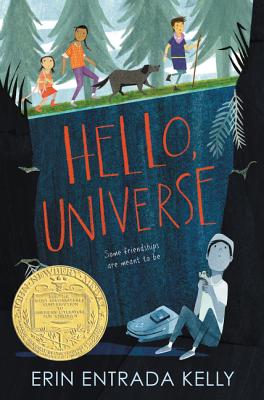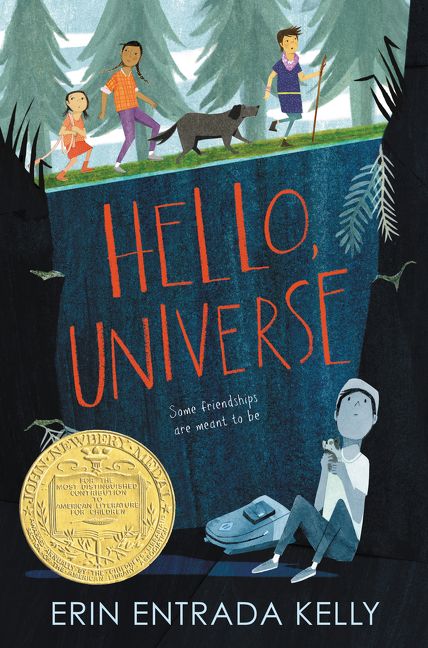craft review by Kristi Wright
HELLO, UNIVERSE by Erin Entrada Kelly won the John Newbery Medal in 2018, a literary award given by the Association for Library Service to Children to the author of “the most distinguished contribution to American Literature for children.”
 On the cover of the book, directly below the HELLO, UNIVERSE title there’s a tagline: “Some friendships are meant to be.” That simple tagline tells potential readers what is special about this book. HELLO, UNIVERSE is all about relationships. It’s the interactions between the characters that advance the plot and that demonstrate how endearing (or not) the characters are.
On the cover of the book, directly below the HELLO, UNIVERSE title there’s a tagline: “Some friendships are meant to be.” That simple tagline tells potential readers what is special about this book. HELLO, UNIVERSE is all about relationships. It’s the interactions between the characters that advance the plot and that demonstrate how endearing (or not) the characters are.
In her fantastic blog post about character relationships, sci-fi/fantasy author, Ruthanne Reid says, “…the relationships between your characters are what make your sweeping plot points and creative world building matter.”
If you look at Newbery award winners–any award winners for that matter–they will always have character relationships that make you feel deeply, whether they crush you or make your heart soar.
In HELLO UNIVERSE, though there are four viewpoint characters, Virgil Salinas is arguably the main character. The other three viewpoint characters are critical to how the story unfolds and their interactions are also heartfelt and worthy of study, but for this post, I’ll focus on Virgil. We become attached to him early on because of his relationships: his interactions with his grandmother, Lola; the guinea pig, Gulliver; his parents and brothers; and of course, the other viewpoint characters.
Virgil’s Secret Kinship With His Grandmother
Virgil’s relationship with his grandmother shows readers that Virgil is lovable. We are introduced to Virgil as he comes home from the last day of sixth grade before summer. He is in a dark place, and the first person he sees is his grandmother.
“They had a secret kinship. It’d been that way ever since the first day she’d come from the Philippines to live with them. On the morning she arrived, Virgil’s parents and identical twin brothers immediately rushed her in a flood of hugs and hellos. With the exception of Virgil, that’s how the Salinas family was–big personalities that bubbled over like pots of soup. Virgil felt like unbuttered toast standing next to them… ‘You are my favorite, Virgilio.’ Then she [his grandmother] put her fingers to her lips and said, ‘Don’t tell your brothers.’” pgs. 3-4.
We learn so much about Virgil in this interaction–that he’s more introverted than the rest of his family, that his grandmother sees something special in him, that she loves him and that he loves her. His grandmother’s love for him makes it easier for us to love him too. It’s truly magical how the way another character perceives your main character can make the reader perceive them that way too!
ACTION: Look for opportunities for secondary characters to show and feel strong positive emotions for your MC–whether it’s love or admiration or liking. When another character likes your MC, the reader is likely to like them too!
Virgil’s Unconditional Love For His Guinea Pig
With Gulliver, the guinea pig, we see not how he feels about Virgil, but how Virgil feels about him. And that’s important too.
“Gulliver was a good friend, guinea pig or not. Virgil could tell him anything and he wouldn’t judge.” pg 17.
We care even more about Virgil because he loves his guinea pig. And later in the story when he puts his life on the line for Gulliver, we love him even more.
“The inky blackness gaped up at him, like the throat of a hungry beast. It smelled musty and dank and deathly. But Gulliver was down there. He couldn’t leave Gulliver–not for a second.” pg 121.
ACTION: Look for opportunities for your main character to sacrifice for someone they love. When your MC shows love and sacrifice, the reader is likely to respond in a deeply profound way.
Virgil’s Complicated Relationship With His Family
Virgil’s parents and brothers act as antagonists in the story. They love him, but they don’t understand him, and due to their lack of understanding they hurt him over and over in small but significant ways. Most readers can relate to a relationship that is hurtful even when there is love. They’ve either experienced it on the schoolyard or at home. By creating this family dynamic, Kelly enables her readers to both root for Virgil and also root for the family dynamic to improve so that the love is pure, not tainted by hurt.
A primary way that Kelly demonstrates this hurtful yet loving relationship is through Virgil’s family nickname, “Turtle.”
“Just as he turned the knob of the front door, his mother said, ‘Don’t wander too far, Turtle. Mahal kita. Be careful.’
He hesitated at the half-open door. ‘Mom?’
‘Yeah?’
Don’t call me that.
It makes me feel like I’m six years old.
It makes me feel like a loser.
‘Mahal kita,” he said, which meant ‘I love you.’
He stepped into the warm sun.”
This is such a powerful interaction between Virgil and his mom. It shows that she loves him AND that she makes him feel terrible. When later in novel, Virgil finally asks his family not to call him that, we the readers weep for all of them.
ACTION: Look for opportunities for your main character to have complicated even hurtful relationships with the people he loves and who love him. Your readers understand those relationships and will respond.
Virgil’s Multifaceted Relationships With Peers
The three other main viewpoints in the book are Valencia, a deaf girl in Virgil’s class whom he has a secret crush on; Kaori Tanaka, a good friend of Virgil’s, who is convinced she has powers of second sight; and Chet Bullens, who is the neighborhood bully and Virgil’s nemesis.
Virgil’s crush on Valencia is sweet and endearing. He’s too shy to talk to her. Most of us can relate to being awkward and having crushes when we were in middle school. We root for Virgil to find the courage to communicate with Valencia.
Virgil and Kaori are long-time friends, but Virgil also is Kaori’s only client for her new psychic service–for children only. He goes to her for guidance over his inability to approach Valencia. Their friendship is reassuring. It shows us that Virgil can interact with other children, that he’s not wholly isolated.
Finally, Chet is the chief antagonist of the story and the person who sets a series of events in motion when he throws Virgil’s backpack down a well. While Kelly does give him a backstory that makes him somewhat sympathetic, we still mostly empathize with Virgil who is being bullied by Chet. We root for Virgil to find the courage to stand up for himself against the boy.
Through these characters, we see that Virgil is multi-faceted. His relationships with these characters give us something to root for and to empathize with. We have strong feelings–we feel angry and we are charmed.
ACTION: Make each of your characters and their relationship with the MC show a different aspect of that MC. Bonus points if the various character relationships create a situation where the MC must grow.
Conclusion
Erin Entrada Kelly masterfully sets up a series of relationships that require her introverted main character, Virgil, to take a stand or forever feel like a failure. He must find the strength to communicate to his family how much it hurts when they call him, “Turtle.” He must tell the bully to stop calling him names. And finally, he must risk his heart and reach out in friendship to Valencia.
This quiet novel packs a powerful punch through its complicated and very relatable relationships.
Now it’s your turn. Review your character relationships. Look for all the ways to tug at your readers’ hearts through how your characters relate to each other. Make your lovable characters, your beautiful plots, and your amazing world building truly matter!
Kristi Wright (co-editor) writes picture books and middle grade novels. Her goal as a writer is to give children a sense of wonder, a hopefulness about humanity, and a belief in their future. She is represented by Kurestin Armada at Root Literary. She is an active volunteer for SCBWI and a 12 X 12 member. Find her at www.kristiwrightauthor.com and on Twitter @KristiWrite.


This is great! Now I (My Daughter) Knows more!
Thank you so much for reading our blog and commenting!
Best,
Anne-Marie and Kristi (co-editors)